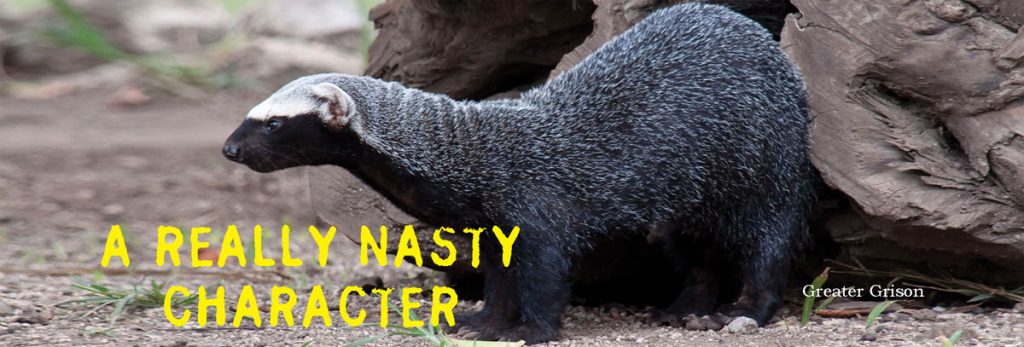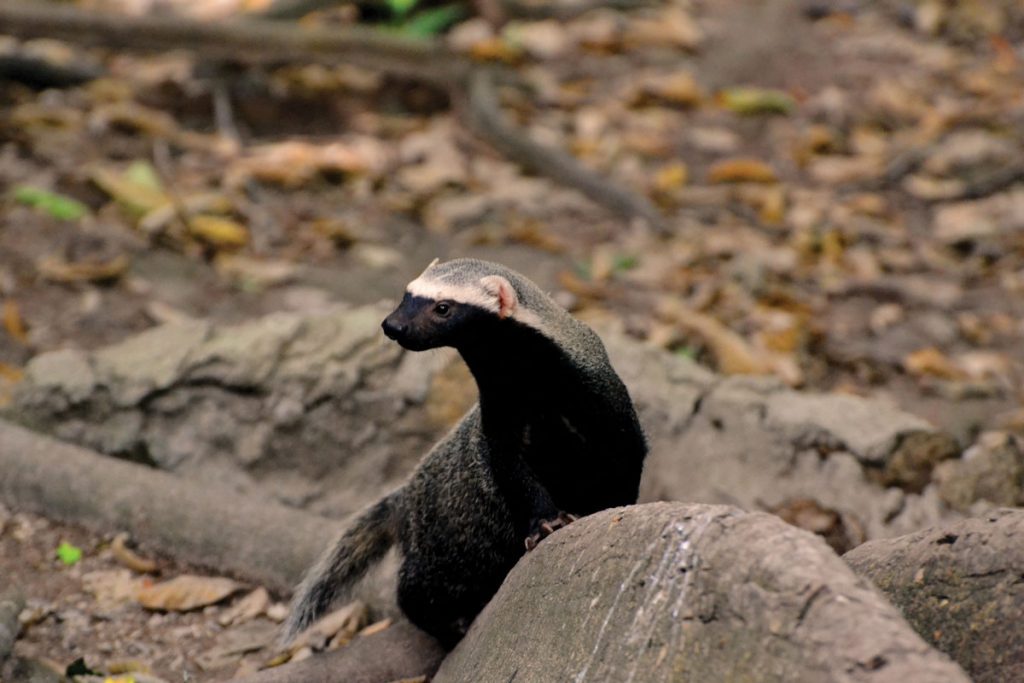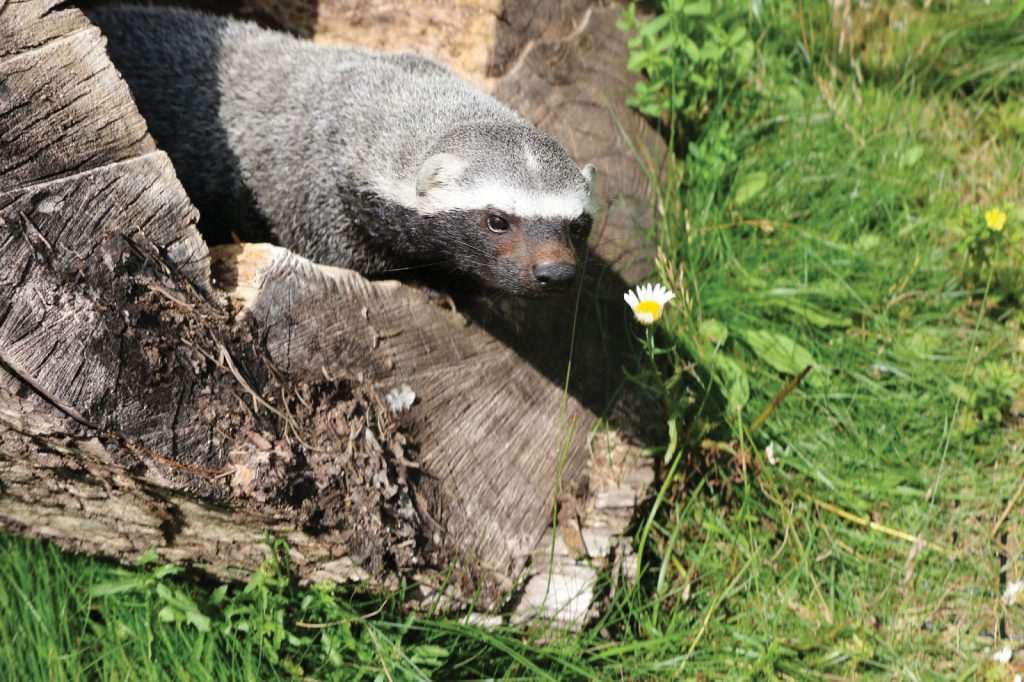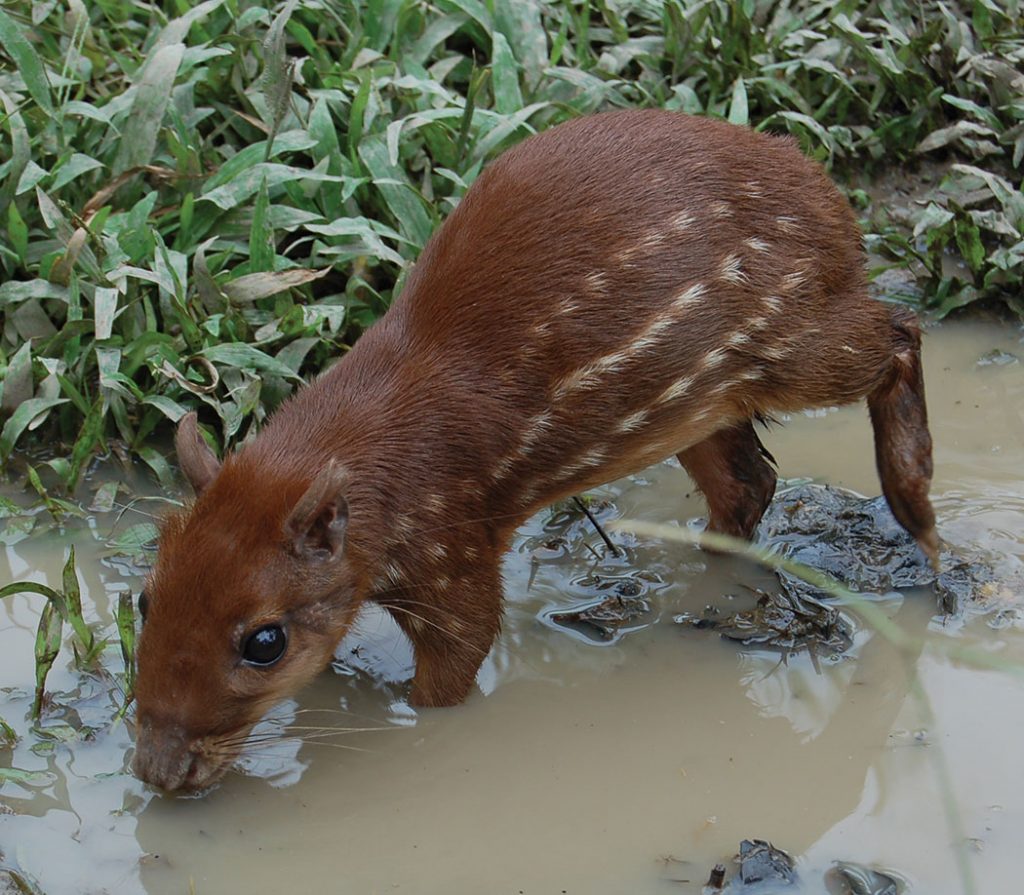A Really Nasty Character

By Jack Ewing
 The book Mammals of Costa Rica by Mark Wainwright describes 21 different species of carnivores found in the country, two from the dog family (canids), six from the raccoon family (procyonids), six from the cat family (felids), and seven from the weasel family (mustelids). This last family boasts some of the toughest and most ferocious animals on the planet, pound for pound. In Costa Rica they are represented by the long-tailed weasel, neotropical river otter, spotted skunk, stripped hog-nosed skunk, hooded skunk, tayra, and the greater grison. This last, the greater grison (Galactis vittata), is distinguished by its ferocity and ability to kill prey considerably larger than itself. I certainly wouldn’t want to tangle with one.
The book Mammals of Costa Rica by Mark Wainwright describes 21 different species of carnivores found in the country, two from the dog family (canids), six from the raccoon family (procyonids), six from the cat family (felids), and seven from the weasel family (mustelids). This last family boasts some of the toughest and most ferocious animals on the planet, pound for pound. In Costa Rica they are represented by the long-tailed weasel, neotropical river otter, spotted skunk, stripped hog-nosed skunk, hooded skunk, tayra, and the greater grison. This last, the greater grison (Galactis vittata), is distinguished by its ferocity and ability to kill prey considerably larger than itself. I certainly wouldn’t want to tangle with one.
Greater grisons are found in the central and southern pacific regions of Costa Rica but are relatively unknown even by people who live in areas where they are found. I did an informal poll of employees at Hacienda Barú National Wildlife Refuge and found that most of the guides and park rangers had heard of the grison, but only four had ever seen one. None of the receptionists or restaurant personnel had ever heard of them. Over the last 45 years I have been privileged to see five greater grisons.
 When we built our first cabins at Hacienda Barú Lodge in 1993 we decided to allow natural vegetation to grow up in a large area between the cabins and the restaurant. The idea was to attract birds and butterflies to the native plants. We jokingly called it the “weed garden”. It did attract plenty of birds and butterflies, but when snakes started crawling out of the thick undergrowth and scaring our guests we cut it down and planted a very attractive garden with flowering shrubs and trees that also attract birds and butterflies but not snakes. Bright and early one morning a greater grison walked out of the weed garden with a large rat clutched firmly between its teeth, sat down in the middle of the driveway in front of cabin #4 and leisurely devoured its prey. Several of the guests were witness to the spectacle. Word got around and the next morning there were about a half dozen spectators.
When we built our first cabins at Hacienda Barú Lodge in 1993 we decided to allow natural vegetation to grow up in a large area between the cabins and the restaurant. The idea was to attract birds and butterflies to the native plants. We jokingly called it the “weed garden”. It did attract plenty of birds and butterflies, but when snakes started crawling out of the thick undergrowth and scaring our guests we cut it down and planted a very attractive garden with flowering shrubs and trees that also attract birds and butterflies but not snakes. Bright and early one morning a greater grison walked out of the weed garden with a large rat clutched firmly between its teeth, sat down in the middle of the driveway in front of cabin #4 and leisurely devoured its prey. Several of the guests were witness to the spectacle. Word got around and the next morning there were about a half dozen spectators.
 They weren’t disappointed. The grison did a repeat performance with another rat, and was photographed by many of the guests. Digital cameras, in those days, were something most people had heard of, but weren’t yet available to the general public. All the photos of the grison were taken with film which had to be developed and printed at a photo lab. I never got to see any of the photos, but several of the guests described the animal to me. It sounded like a species I had observed two years earlier when a pair of them sauntered across an open area alongside of one of our nature trails. I later learned that they were greater grisons. The next morning I went to the cabins before 6:00 am and was privileged, along with around 15 others, to observe the gray colored mammal with a black nose, throat, and legs consuming its third rat. The grison was oblivious to all of the people and payed no attention to their oohs and aahs. It showed no sign of fear and took its time eating breakfast even though some of the people walked up to within about 10 meters (32 feet) to take photos. The fourth morning was the final act. I suppose the rat population in the weed garden had been decimated and the grison moved on to more productive hunting grounds.
They weren’t disappointed. The grison did a repeat performance with another rat, and was photographed by many of the guests. Digital cameras, in those days, were something most people had heard of, but weren’t yet available to the general public. All the photos of the grison were taken with film which had to be developed and printed at a photo lab. I never got to see any of the photos, but several of the guests described the animal to me. It sounded like a species I had observed two years earlier when a pair of them sauntered across an open area alongside of one of our nature trails. I later learned that they were greater grisons. The next morning I went to the cabins before 6:00 am and was privileged, along with around 15 others, to observe the gray colored mammal with a black nose, throat, and legs consuming its third rat. The grison was oblivious to all of the people and payed no attention to their oohs and aahs. It showed no sign of fear and took its time eating breakfast even though some of the people walked up to within about 10 meters (32 feet) to take photos. The fourth morning was the final act. I suppose the rat population in the weed garden had been decimated and the grison moved on to more productive hunting grounds.
The last greater grisons I saw were crossing the road in the mid 2000s before the construction of the new highway. I was bumping along over the rough, pot hole laden road in my pickup when I spotted the pair crossing about 100 meters (110 yards) in front of me and entering the thick roadside vegetation. As I neared the point where they had crossed I detected some movement off to the right. An enormous iguana, half again as heavy as a grison, came charging out of the weeds and into the road with one of the grisons right on its tail. With a lunge the mammal caught and bit down on one of the reptile’s back feet and hung on tight. When in a life threatening situation an iguana will often play dead, and that’s what this one did. This trick will fool a dog which will drop its prey, lie down, and pant, with pride radiating from its face. The second the dog looks the other direction the iguana is up and running, and often escapes. The grison was too smart to fall for this ploy. It pulled hard on the foot, lunged forward, and bit down on the thigh, then the back and finally the neck, severing the spinal cord. It then dragged the dead iguana off into the weeds, presumably to share with its mate.

A couple of years ago one of the park rangers called and said he had something he wanted me to see. I went to the designated location where he showed me the skull and partial skeleton of an adult paca. A paca is a rodent that can weigh up to 10 kilos (22 pounds) It reminds me of a large guinea pig. The skull still had a few bits of skin attached and gave the appearance of having been killed fairly recently. We puzzled over what might have killed it and decided that it had to have been a coyote, an ocelot, or maybe even a puma. Nothing else we could think of was big enough to tangle with a paca. Though not a carnivore a paca puts up a vigorous fight when cornered or grabbed and becomes quite aggressive. It has sharp incisors which can inflict an ugly wound. A predator wouldn’t want to risk that unless it could kill the paca with almost no chance of getting bitten. The piece of the puzzle that had us scratching our heads was that the skull was found near the mouth of a small cave in an embankment, and none of the above mentioned predators would fit in the opening. I’m sure that you have guessed that the killer turned out to be a greater grison. A guide spotted it near the cave a few days later. The amazing thing about this story is that a paca weighs about three times as much as a grison whose maximum weight is around 3 kilos (6½ pounds). That is one battle I would have liked to witness.
Very little is known about the behavior of wild grisons compared to our knowledge of other mammals. They are seldom seen, and are next to impossible to radio collar. With small heads and thick necks the collars tend to slip off. Information from one radio collared female that kept the collar on for almost a month shows that they may have a home range of over 4 square kilometers (more than 1000 acres). If they defend a territory that large against other grisons, it could explain why there are so few sightings. For the last seven years I have had six to eight trail cameras placed at different locations within the Hacienda Barú National Wildlife Refuge, and have never once captured a photo or video of a grison.
Most of what has been written about the greater grison describes them as very wary of humans. In contrast to those reports everyone I talked to who had seen one described them as totally unafraid of humans. I would go so far as to describe the greater grison as arrogant. Every one that I have seen has been aware of my presence, but all gave the impression that they just couldn’t care less and paid no attention to me.
A lot of what is known about the grison has come from the observation of captive animals. Among other things biologists have learned that their gestation period is 39 days, and they give birth to two to four offspring, between March and September. They can climb trees and are good swimmers. In fact their five toes are webbed. Grisons have scent glands similar to those of their close relatives the skunks and will release an oily substance with extremely disgusting odor if pursued or attacked.
It has been reported that grisons captured at a very young age and reared by humans grow up to be nice pets. I tend to wonder how they would get along with other pets in the house. From what little I have learned and observed about the greater grison, I shudder at the thought of allowing one to play with my wife’s favorite kitten.

